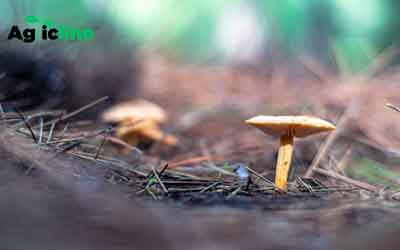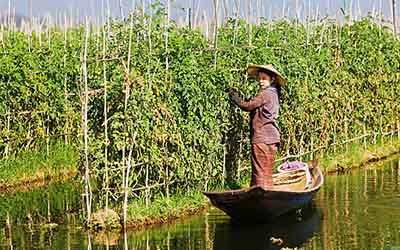Today, I will be highlighting the Most common bacteria found in soil and the importance of soil bacteria. Soil bacteria are the unsung heroes of our planet’s ecosystems and the cornerstone of modern agriculture.
These microscopic organisms play a critical role in maintaining soil health, supporting plant growth, and ensuring the sustainability of our natural and farmed landscapes.
Their activities underpin the cycling of nutrients, such as nitrogen, phosphorus, and sulfur, which are essential for life on Earth.
Moreover, soil bacteria contribute to the decomposition of organic matter, enriching the soil and making it fertile.
Their ability to fix atmospheric nitrogen also reduces the need for synthetic fertilizers, offering a more sustainable approach to agriculture.
The diversity of bacterial life in soil is astonishing. A single gram of soil can contain tens of billions of bacteria, encompassing thousands of different species, each with its unique role in the soil ecosystem.
Understanding Soil Bacteria
Soil bacteria are a broad category that includes a variety of microorganisms, each adapted to specific environmental conditions and roles within their ecosystems.
These organisms range from those that thrive in oxygen-rich environments to those that prefer conditions where oxygen is scarce.
Their existence is pivotal for breaking down organic matter, recycling nutrients, and transforming soil minerals into forms that plants can easily absorb.
Adaptation and Survival
Soil bacteria have adapted to survive in a wide range of conditions, from hot deserts to cold tundras.
This adaptability is seen not only in their physical survival but also in their metabolic capabilities.
Some bacteria can digest pollutants, offering potential solutions for bioremediation, while others can produce antibiotics, helping to suppress soilborne diseases.
Common Genera of Bacteria Found in Soil
These bacteria are not only numerous but also crucial for various ecological processes, such as nutrient cycling, disease suppression, and the promotion of plant growth.
- Nitrosomonas and Nitrobacter
- Rhizobium
- Pseudomonas
- Actinobacteria
- Bacillus
Nitrosomonas and Nitrobacter
These bacteria are key players in the nitrogen cycle, an essential process for converting nitrogen from the atmosphere into a form that plants can use.
Nitrosomonas converts ammonia into nitrites, while Nitrobacter takes these nitrites and converts them into nitrates, a form of nitrogen that plants can easily absorb.
Rhizobium
Rhizobium bacteria form symbiotic relationships with leguminous plants (such as peas, beans, and clover) by colonizing their roots and forming nodules.
Within these nodules, Rhizobium converts atmospheric nitrogen into ammonia, directly providing the host plant with an essential nutrient.
This process reduces the need for synthetic nitrogen fertilizers, promoting more sustainable agricultural practices.
Pseudomonas
Pseudomonas species are renowned for their role in suppressing soilborne diseases and promoting plant growth.
They produce a variety of antibiotics that inhibit the growth of harmful pathogens, protect plant roots from diseases, and can also produce substances that stimulate plant growth.
Their ability to degrade pollutants also makes them valuable for bioremediation efforts.
Actinobacteria
Actinobacteria are crucial for the decomposition of organic matter, helping to break down complex molecules like cellulose and lignin in dead plant material.
This process releases nutrients back into the soil, contributing to soil fertility. Actinobacteria also help in forming soil structure, which is essential for water retention and aeration.
Bacillus
Bacillus species are notable for their ability to produce antibiotics and enzymes that can suppress soilborne pathogens, thereby protecting plant health.
Some species also promote plant growth by producing phytohormones and solubilizing phosphorus, making it more available to plants.
Their endospores’ ability to survive in harsh conditions makes them a resilient component of the soil microbiome.
The Ecological Roles of Soil Bacteria
Soil bacteria are fundamental to the health and functionality of terrestrial ecosystems, performing a range of ecological roles that underpin the nutrient cycles, support plant growth, and maintain soil structure.
Their activities are crucial for the productivity of natural and agricultural ecosystems, affecting everything from crop yield to the resilience of natural landscapes against climate change.
This section explores the key ecological roles of soil bacteria, highlighting how these microorganisms contribute to ecosystem services that are vital for life on Earth.
Nitrogen Fixation
- Transforming Atmospheric Nitrogen: One of the most critical roles of certain soil bacteria, such as those in the genera Rhizobium, is nitrogen fixation.
This process involves converting atmospheric nitrogen gas, which is inert and unavailable to plants, into ammonia, a form that plants can assimilate.
Decomposition and Organic Matter Breakdown
- Recycling Nutrients: Soil bacteria are pivotal in decomposing organic matter, including dead plants, animals, and microbial biomass.
This decomposition process is fundamental to the recycling of nutrients, transforming organic matter into mineral forms that plants can easily uptake.
Actinobacteria, for example, play a significant role in breaking down complex compounds like cellulose and lignin, releasing carbon, nitrogen, and other nutrients back into the soil.
Disease Suppression and Plant Protection
- Natural Biocontrol Agents: Certain soil bacteria, such as Pseudomonas and Bacillus, act as natural biocontrol agents by producing antibiotics and other compounds that suppress plant pathogens.
This biocontrol mechanism can significantly reduce the prevalence of diseases in crops and natural vegetation, reducing the need for chemical pesticides and contributing to more sustainable agricultural practices.
Bioremediation
- Cleaning Up Soil Contamination: Some soil bacteria have the remarkable ability to degrade or transform pollutants, including hydrocarbons, heavy metals, and pesticides, into less harmful substances.
This process, known as bioremediation, is a natural way of cleaning contaminated soils, making it an invaluable tool for environmental restoration efforts.
Soil Structure Formation and Stability
- Building a Healthy Soil Environment: Beyond their roles in nutrient cycling and plant health, soil bacteria also contribute to the physical structure of soil.
By producing slime and other extracellular substances, bacteria help bind soil particles together, forming aggregates that improve soil structure.
This enhanced soil structure benefits plant growth by improving water retention, aeration, and resistance to erosion.
Factors Influencing the Distribution and Diversity of Soil Bacteria
The distribution and diversity of soil bacteria are influenced by a complex interplay of environmental, biological, and anthropogenic factors.
These factors determine not only the types of bacteria present in a given soil but also their functional roles within the ecosystem.
Soil Type and Texture
The physical characteristics of soil, including its type (clay, loam, sand, etc.) and texture, significantly influence bacterial communities.
Soil texture affects water retention, aeration, and nutrient availability, creating habitats that favor certain bacteria over others.
For instance, clay soils, with their high nutrient content and moisture retention, can support a more diverse bacterial population than sandy soils, which are drier and less nutrient-rich.
Moisture and Temperature
Moisture and temperature are among the most critical environmental factors affecting soil bacteria. These conditions influence bacterial metabolism, growth rates, and survival.
High moisture levels generally promote bacterial activity and diversity, while extreme temperatures (either hot or cold) can limit bacterial growth, selecting for more resilient or specialized species.
Plant Types and Root Exudates
The types of plants growing in a soil can significantly influence its bacterial community.
Plants release a variety of organic compounds through their roots, known as root exudates, which can attract specific bacteria beneficial for plant growth.
This symbiotic relationship shapes the soil’s microbial community, with different plant species supporting distinct bacterial populations through their unique exudate compositions.
Agricultural Practices
Farming techniques such as crop rotation, tillage, the use of fertilizers, and pesticides have profound effects on soil bacterial communities.
Some practices, like organic farming and reduced tillage, can enhance bacterial diversity and function by maintaining soil structure and reducing chemical inputs.
pH and Chemical Composition
The pH and overall chemical composition of soil are also critical in shaping bacterial communities.
Soil pH affects the availability of nutrients and can influence the survival of certain bacteria.
What is the Significance of Studying Soil Bacteria?
The study of soil bacteria is a window into understanding the vast, complex, and dynamic world beneath our feet—a world that is crucial for the health of our planet’s ecosystems and the sustainability of human societies.
Advancing Sustainable Agriculture
The insights gained from studying soil bacteria can lead to more sustainable agricultural practices.
Understanding the roles of different bacteria in nutrient cycling, plant health, and soil structure allows for the development of farming techniques that reduce chemical inputs, such as fertilizers and pesticides, and enhance crop yields naturally.
Environmental Restoration and Conservation
Soil bacteria play a key role in environmental restoration efforts, particularly through the process of bioremediation.
By harnessing the natural abilities of bacteria to degrade pollutants, scientists can clean up contaminated soils, restoring them to health and preventing the spread of pollutants to waterways and other ecosystems.
Biotechnological and Industrial Applications
The study of soil bacteria has also opened the door to numerous biotechnological and industrial applications.
From the production of antibiotics and enzymes to the development of biofuels and bioplastics, soil bacteria are a rich source of biochemicals with commercial potential.
Enhancing Soil Health and Ecosystem Services
A deeper understanding of soil bacterial communities contributes to the broader goal of enhancing soil health and the ecosystem services it provides.
Soil health is fundamental to water purification, carbon sequestration, and the prevention of erosion—services that are vital for environmental health and human well-being.

Conclusion on the most common bacteria found in soil
Understanding the importance of soil bacteria and their roles within ecosystems opens up pathways for advancing sustainable agricultural practices, developing new biotechnologies, and addressing environmental challenges.
It underscores the necessity of adopting practices that protect and enhance microbial diversity in soils, recognizing that such diversity is crucial for the health of our planet.
As we continue to explore and understand this hidden universe, we open the door to discoveries that can nourish our planet, safeguard our environment, and sustain future generations.
Recommendations
6 Problems faced by farmers in getting loans
8 Difference between gardening and farming
Best Water management technology in agriculture
Best farming technology in India



